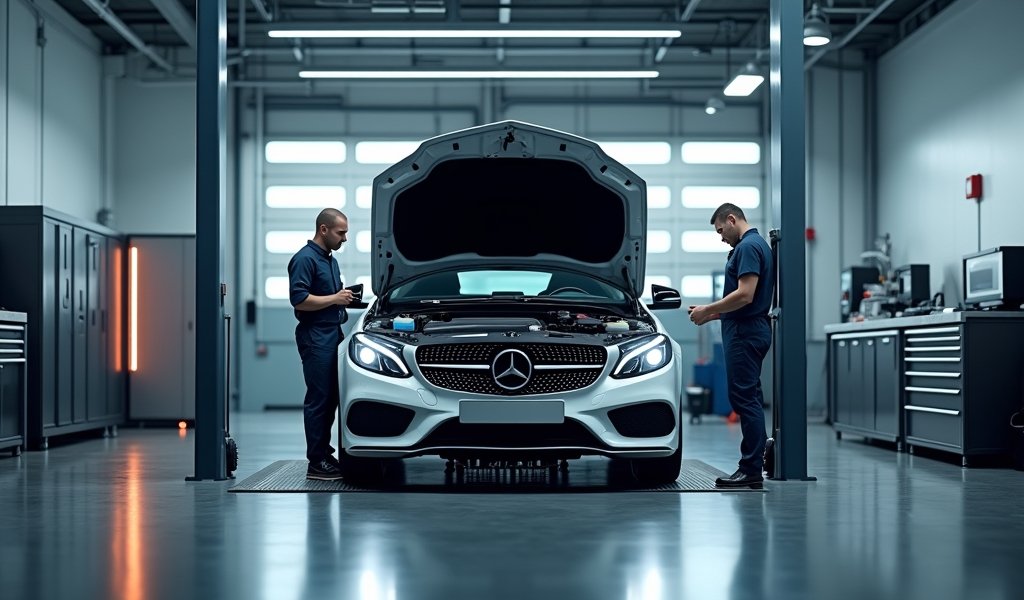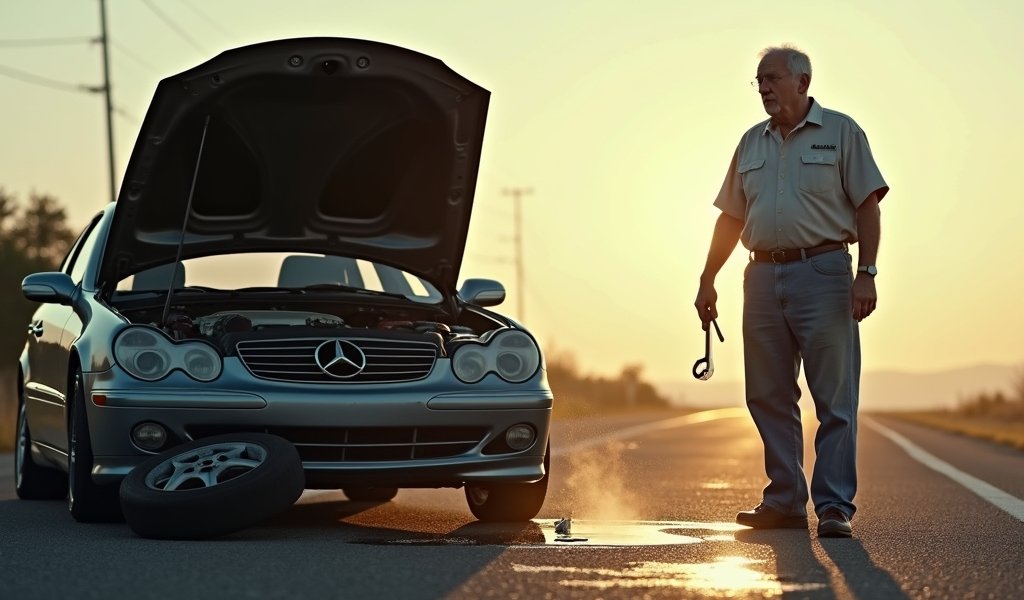Overview
This article outlines essential car inspection and maintenance tasks to perform before long road trips, including checking fluids, tires, brakes, battery, and under-hood components. It emphasizes how taking 60-90 minutes for thorough preparation can prevent breakdowns and save travelers from costly roadside repairs, wasted vacation time, and safety risks.
Table of Contents
- Introduction
- Why Pre-Trip Inspections Matter
- Essential Fluid Checks
- Tire Inspection Secrets
- Battery and Electrical System
- Brake System Inspection
- Under-the-Hood Essentials
- Emergency Preparedness
- Professional vs. DIY Inspection
- Conclusion
- Frequently Asked Questions
Introduction
You’ve got the route planned, accommodations booked, and a playlist that’ll last the entire journey. But have you checked if your car is as ready for the adventure as you are? As a mechanic with over 15 years of experience, I’ve seen too many excited travelers stranded on roadsides with issues that a simple car inspection before their long drive could have prevented.
That perfect road trip can quickly turn into a costly nightmare when your vehicle decides to protest halfway through. According to AAA’s research, over 30 million drivers face breakdowns annually, with numbers spiking during peak travel seasons. The truly frustrating part? Nearly 40% of these situations could have been avoided with basic pre-trip checks.
Let’s walk through the essential inspection points that should be on every driver’s pre-trip checklist, helping ensure your journey stays memorable for all the right reasons.
Why Pre-Trip Inspections Matter
Think of a car inspection before a long drive as preventive medicine for your vehicle. Just like you wouldn’t run a marathon without training, your car shouldn’t tackle hundreds of miles without preparation. Long-distance driving puts unique stresses on vehicle systems that daily commuting doesn’t.
Highway driving means sustained higher speeds, which increases operating temperatures across multiple components. Your cooling system, transmission, and engine oil all work harder when maintaining steady high speeds. Different elevation changes can affect everything from tire pressure to fuel efficiency.
Taking 60-90 minutes for a thorough inspection can save you:
- Expensive roadside repairs (often 2-3 times the normal cost)
- Lost vacation time (the average breakdown steals 14+ hours from your trip)
- Safety risks to you and your passengers
- The stress and frustration of unexpected problems
A comprehensive car inspection checklist isn’t just smart—it’s essential for any journey longer than your usual daily driving routine.

Essential Fluid Checks
Your car relies on several vital fluids to function properly, and checking them before a long journey is like ensuring you’ve packed enough water for a hike. Let’s look at what needs your attention:
Engine Oil
This is your engine’s lifeblood. Park on level ground and check the oil when the engine is cool for the most accurate reading. Pull the dipstick, wipe it clean, reinsert it fully, then check the level and color. Fresh oil appears amber and translucent. If your oil looks dark and gritty or smells burnt, schedule an oil change before your trip even if you’re not quite at the recommended interval.
Remember that highway driving can be easier on your engine than city driving, but sustained high speeds demand clean, quality oil at the proper level.
Coolant/Antifreeze
Never open the radiator cap when the engine is hot! Check the coolant reservoir level when cool—the fluid should sit between the “min” and “max” markers. The color should be clear, not rusty or cloudy. If it’s been more than two years since your last coolant flush, consider having this done before a major trip, especially if you’re heading into extreme temperatures.
Brake Fluid
Locate the brake fluid reservoir (typically mounted on the firewall) and verify the level is within the indicated range. The fluid should be clear with an amber tint—dark fluid indicates contamination and requires professional attention. Low brake fluid often points to worn brake pads or a potential leak that needs addressing before highway driving.
Transmission Fluid
Unlike other fluids, transmission fluid should be checked with the engine running and warm, following your vehicle’s specific procedure. Look for bright red fluid without a burnt smell. Brown or dark fluid with a burnt odor indicates internal transmission issues that merit professional attention before your journey.
Power Steering Fluid
Low power steering fluid makes steering difficult—dangerous during high-speed highway maneuvers. Check with the engine running for the most accurate reading, and top off if needed with the manufacturer-recommended type.
Windshield Washer Fluid
This simple check is often overlooked until you’re facing a bug-splattered windshield at 70 mph. Fill with a quality fluid that helps remove insects and road grime. Consider carrying an extra gallon for long trips, especially through bug-heavy regions or during summer travel.
Tire Inspection Secrets
Your tires are quite literally where the rubber meets the road. They affect everything from fuel economy to handling and safety. Here are the tire inspection secrets every road-tripper should know:
Proper Pressure Technique
Always check tire pressure when tires are cold—meaning the car hasn’t been driven for at least three hours. Hot tires give falsely elevated readings that could leave you underinflated once temperatures normalize. Set pressure to the manufacturer’s specifications found in your door jamb or owner’s manual—not the maximum PSI listed on the tire itself.
For long highway trips, some manufacturers recommend setting pressure 2-3 PSI higher than normal to account for added load and sustained high speeds. Check your owner’s manual for specific guidance.
Tread Depth Assessment
While the penny test works (insert a penny with Lincoln’s head upside down; if you can see all of his head, your tread is too worn), consider investing in an inexpensive tread depth gauge for more precision. For long highway trips, you want at least 4/32″ of tread remaining—more if you expect rain or adverse conditions.
Pay special attention to uneven wear patterns. If the center of your tread is more worn than the edges, you’ve been driving overinflated. If the edges show more wear, you’ve been running underinflated. Both conditions can lead to reduced traction and potential blowouts.
Inspecting for Damage
Run your hand (carefully!) along each tire when cool, feeling for bulges, cuts, or embedded objects. Pay special attention to sidewalls, where damage often hides and can lead to dangerous blowouts at highway speeds. Look for tiny cracks in the rubber—signs of aging that become especially dangerous during long drives.
Don’t forget to prepare your car for long road trips by checking the often-neglected spare tire. A flat spare is useless in an emergency, so verify its pressure and condition. If you have a temporary donut spare, remember it’s typically limited to 50 mph and 50-100 miles of use.
Rotation Considerations
If you’re approaching the recommended rotation interval (typically every 5,000-7,500 miles), have your tires rotated before the trip. This ensures even wear and maximum tread life during your journey. Many shops will perform a courtesy inspection when you come in for rotation—take advantage of this extra set of eyes.
Battery and Electrical System
Nothing ends a road trip faster than electrical failure. Your vehicle’s battery and electrical system deserve thorough attention before departure.
Battery Health Check
Modern batteries typically last 3-5 years, but extreme temperatures can shorten their lifespan dramatically. If your battery is approaching the three-year mark, have it tested professionally before your trip. Most auto parts stores offer free battery testing—a service well worth the short detour.
Check battery terminals for corrosion (white or greenish powder). Clean them using a mixture of baking soda and water, followed by a wire brush. Ensure connections are tight but not over-tightened, which can damage the battery posts.
Lighting Inspection
Enlist a helper to verify all exterior lights are functioning properly. This includes headlights (high and low beams), brake lights, turn signals, hazards, and running lights. Replace any burnt bulbs before departure—being able to communicate with other drivers through proper lighting is essential for safe highway travel.
While checking headlights, look for yellowing or foggy lenses. A simple headlight restoration kit can dramatically improve night visibility if your lenses have clouded with age.
Fuse Preparedness
Locate your vehicle’s fuse box (usually under the dashboard or hood) and carry a few spare fuses of various amperages. A blown fuse during a trip can disable critical systems, from power windows to fuel pumps. Your owner’s manual shows fuse locations and ratings—take a photo with your phone for quick reference.
Consider packing a basic multimeter if you’re traveling to remote areas. This inexpensive tool can help diagnose simple electrical issues if you encounter problems during your journey.

Brake System Inspection
Your brakes are your primary safety system, especially crucial during long drives where you’ll encounter varying terrain and traffic conditions. Here’s what to check before hitting the open road:
Brake Pad Condition
Listen for squealing or grinding noises when braking—the most obvious indicators of worn pads. Many vehicles allow visual inspection of pad thickness through the wheel spokes. Look for at least 1/4 inch of pad material. Most modern pads include wear indicators that create a squealing sound when replacement is needed.
If you’re approaching the 30,000-50,000 mile mark on your current pads, consider replacement before a major journey, especially if you’ll be traveling through mountainous terrain where braking demands increase significantly.
Brake Fluid System
Beyond checking fluid levels mentioned earlier, inspect under the vehicle for any fluid leaks around wheels or brake components. The brake pedal should feel firm, not spongy or excessively hard. If it sinks to the floor or requires pumping to build pressure, have your system professionally checked immediately.
On a slight incline, test your parking brake by engaging it and putting the transmission in neutral. The vehicle should remain stationary, indicating proper function—crucial if you’ll be parking in hilly areas during your journey.
Brake Performance Test
Find a safe, empty parking lot or quiet road to test your brakes. Accelerate to about 30 mph and brake firmly (not slamming). The car should stop in a straight line without pulling to either side. Any pulling, vibration, or pulsation indicates problems that need addressing before highway travel.
Remember that loaded vehicles require greater stopping distances. If you’ll be traveling with a full car and luggage, adjust your driving style to allow for extra stopping distance, especially during the first few hours while you adapt to the vehicle’s loaded handling characteristics.
Under-the-Hood Essentials
Looking beyond fluids, several under-hood components deserve your attention before embarking on a long journey:
Belt Inspection
Modern vehicles typically use a single serpentine belt to drive multiple accessories. Examine this crucial component for cracks, fraying, or glazing. Unlike older V-belts, modern serpentine belts don’t always show obvious cracks when worn—look for glazing or missing chunks of ribbing.
A failed belt can simultaneously disable your alternator, water pump, power steering, and A/C—a cascade of problems you don’t want to experience hundreds of miles from home. If your belt is approaching the 60,000-100,000 mile mark, consider proactive replacement before your trip.
Hose Examination
Squeeze coolant hoses (when the engine is cool!) to check for softness, hardness, or cracking. They should feel firm but slightly flexible. Pay special attention to connection points where leaks often begin. Look for any evidence of seepage or dried coolant residue around hose clamps.
Radiator and heater hoses typically last 4-5 years before degrading. If yours are approaching this age, replacement before a major trip provides valuable peace of mind.
Air Filter Check
A clogged air filter reduces engine performance and fuel economy—costly on long trips. Remove and hold your air filter up to a bright light; if light doesn’t pass through easily, it’s replacement time. This five-minute, inexpensive maintenance item can improve fuel economy by up to 10% on highway drives.
While checking the engine air filter, don’t forget the cabin air filter that affects your breathing environment. A fresh cabin filter improves air conditioning performance and keeps allergens at bay during long drives.
Connection Verification
Ensure all visible electrical connections are secure. Look for disconnected sensors, loose battery cables, or damaged wiring that could cause mysterious problems on your journey. Pay particular attention to any check engine light—address these warnings before departure, as they often indicate issues that could worsen during extended driving.
Consider a car service checklist that covers these critical points if you’re uncomfortable performing these checks yourself.
Emergency Preparedness
Even with perfect preparation, emergencies can happen. Being ready for the unexpected shows the same foresight as your pre-trip inspection:
Essential Tools
Pack a basic toolkit including jumper cables, screwdrivers (flathead and Phillips), adjustable wrench, pliers, tire pressure gauge, and a portable air compressor. Add a quality flashlight with fresh batteries and reflective triangles for roadside visibility if you need to stop unexpectedly.
Consider a battery jump starter pack with USB charging capabilities—these compact devices can jump-start your vehicle without another car and charge mobile devices during emergencies.
Comfort and Safety Items
Include a first-aid kit, bottled water, non-perishable snacks, blankets, and weather-appropriate extras. Summer journeys require sunscreen and extra water, while winter trips demand ice scrapers, gloves, and emergency warmth items like hand warmers or extra blankets.
Don’t forget phone chargers and portable battery packs. While we hope you won’t need to call for help, ensuring your communication devices stay powered is essential for modern emergency management.
Documentation Readiness
Carry your vehicle registration, insurance information, and roadside assistance details. Program emergency contacts into your phone under “ICE” (In Case of Emergency). Consider storing digital copies of important documents in your email or cloud storage as backup.
Many insurance policies and credit cards include roadside assistance—know your coverage details before you need them. Program these contact numbers into your phone for quick access during stressful situations.
Professional vs. DIY Inspection
While many inspection points are DIY-friendly, sometimes professional expertise provides valuable insurance against road trip disasters.
When to Seek Professional Help
Consider professional inspection if:
- You notice unusual noises, vibrations, or warning lights
- Your journey will be particularly long (1,000+ miles) or through remote areas
- The vehicle is approaching major service intervals
- You’re uncomfortable performing mechanical inspections yourself
- It’s been more than six months since your last professional service
Many service centers offer pre-trip inspection packages at reasonable rates—typically $50-$100. This small investment could save thousands in emergency repairs and salvage precious vacation time.
Professional Inspection Advantages
Mechanics have equipment you likely don’t—lifts to check underneath your vehicle thoroughly, diagnostic tools to assess electronic systems, and trained eyes that can spot subtle issues before they become problems. As Consumer Reports notes, professional inspections often catch issues that aren’t obvious to even careful DIY inspectors.
If you’re planning a trip with challenging driving conditions—extreme heat, mountain passes, or remote areas—professional insight becomes even more valuable. The peace of mind alone is worth the modest expense.
Conclusion
A thorough car inspection before a long drive represents one of the best investments you can make in your journey’s success. The 60-90 minutes you’ll spend checking fluids, tires, brakes, and other essentials can prevent hours of delays, thousands in emergency repairs, and the disappointment of interrupted plans.
Remember that highway driving creates unique stresses on your vehicle—sustained speeds, varying elevations, and extended operation times tax systems differently than daily commuting. Your preparation should account for these demands.
Whether you choose the DIY approach or seek professional assistance, the key is being proactive rather than reactive. As we mechanics often say, “You can inspect it now at your convenience, or inspect it later at the side of the road.” I know which option I’d choose for my family’s vacation.
Safe travels, and may your journey be memorable for all the right reasons!
Frequently Asked Questions
How long before a road trip should I inspect my car?
Ideally, inspect your car 1-2 weeks before your trip. This provides adequate time to address any issues that might require parts ordering or scheduling service appointments.
What fluids should I check before a long drive?
Check engine oil, coolant/antifreeze, brake fluid, power steering fluid, transmission fluid, and windshield washer fluid. Each plays a critical role in your vehicle’s performance and safety during extended drives.
Do I need a professional inspection before every road trip?
Not necessarily for every trip, but professional inspection is recommended for journeys over 1,000 miles or if your vehicle has over 75,000 miles. DIY inspections are often sufficient for shorter trips with newer, well-maintained vehicles.
What tire pressure should I use for long highway drives?
Use the manufacturer’s recommended pressure found in your door jamb or owner’s manual, not the maximum PSI on the tire itself. Some manufacturers suggest adding 2-3 PSI above normal for heavily loaded vehicles on long trips.
What emergency items should I always keep in my car for long trips?
Always carry jumper cables, a first-aid kit, flashlight, basic tools, water, non-perishable snacks, phone charger, and roadside assistance information. Add season-appropriate items like blankets for winter or extra water for summer travel.


Pingback: oil change before long drive: 3 Pro Tips - knowsyourcar.com